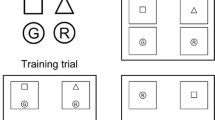Abstract
We examined eye movements in younger and older adults during conditional discrimination training and testing for responding in accordance with stimulus equivalence. During training, we measured fixation duration and fixation rate for both the sample and comparison stimuli. During testing, we measured fixation duration and fixation rate for the comparison stimuli only. In addition, we measured the establishment of conditional discriminations and likelihood of responding in accordance with stimulus equivalence. The results showed that the effect of the differential reinforcement procedure occurred more slowly in the older participants. Fixation rate and fixation duration toward the sample stimulus was similar for both groups, whereas fixation rate and fixation duration toward the comparison stimuli were generally higher for the older adults, particularly for those who failed to respond in accordance with stimulus equivalence. Fixation rate and fixation duration generally decreased across training, with a stepwise increase in both behaviors during testing of the baseline conditional discriminations, symmetry, and equivalence relations. The same pattern recurred in the last part of testing, although generally with shorter fixation durations and lower fixation rates relative to the beginning of testing.








Similar content being viewed by others
References
Arntzen, E., & Haugland, S. (2012). Titration of limited hold to comparison in conditional discrimination training and stimulus equivalence testing. The Psychological Record, 62, 243–262. Retrieved from http://thepsychologicalrecord.siuc.edu/index.html.
Arntzen, E., Nartey, R. K., & Fields, L. (2015). Enhanced equivalence class formation by the delay and relational functions of meaningful stimuli. Journal of the Experimental Analysis of Behavior, 103, 524–541. doi:10.1002/jeab.152.
Arntzen, E., Norbom, A., & Fields, L. (2015). Sorting: An alternative measure of class formation? The Psychological Record, 1–11. doi:10.1007/s40732-015-0132-5.
Baker, J. C., & LeBlanc, L. A. (2014). Aging. In F. K. McSweeney & E. S. Murphy (Eds.), The Wiley Blackwell handbook of operant and classical conditioning (pp. 695–713). New York: Wiley.
Baron, A., & Menich, S. R. (1985). Reaction times of younger and older men: Effects of compound samples and a prechoice signal on delayed matching-to-sample performances. Journal of the Experimental Analysis of Behavior, 44, 1–14. doi:10.1901/jeab.1985.44-1.
Baron, A., Menich, S. R., & Perone, M. (1983). Reaction times of younger and older men and temporal contingencies of reinforcement. Journal of the Experimental Analysis of Behavior, 40, 275–287. doi:10.1901/jeab.1983.40-275.
Bortoloti, R., Rodrigues, N. C., Cortez, M. D., Pimentel, N., & de Rose, J. C. (2013). Overtraining increases the strength of equivalence relations. Psychology & Neuroscience, 6, 357–364. doi:10.3922/j.psns.2013.3.13.
Dinsmoor, J. A. (1985). The role of observing and attention in establishing stimulus control. Journal of the Experimental Analysis of Behavior, 43, 365–381. doi:10.1901/jeab.1985.43-365.
Dube, W.V., Balsamo, L.M., Fowler, T.R., Dickson, C.A., Lombard, K.M., & Tomanari, G. Y. (2006). Observing behavior topography in delayed matching to multiple samples. The Psychological Record, 56, 233–244. Retrieved from http://thepsychologicalrecord.siu.edu/index.html
Dube, W.V., Dickson, C.A., Balsamo, L.M., O'Donnell, K.L., Tomanari, G.Y., Farren, K. M., . . . McIlvane, W.J. (2010). Observing behavior and atypically restricted stimulus control. Journal of the Experimental Analysis of Behavior, 94, 297–313. doi:10.1901/jeab.2010.94-297.
Dube, W. V., Lombard, K. M., Farren, K. M., Flusser, D. S., Balsamo, L. M., Fowler, T. R., & Tomanari, G. Y. (2003). Stimulus overselectivity and observing behavior in individuals with mental retardation. In S. Soraci & K. Murata-Soraci (Eds.), Visual information processing (pp. 109–123). Westport: Greenwood Publishing Group.
Dube, W.V., Lombard, K.M., Farren, K.M., Flusser, D.S., Balsamo, L.M., & Fowler, T.R. (1999). Eye tracking assessment of stimulus overselectivity in individuals with mental retardation. Experimental Analysis of Human Behavior Bulletin, 17, 267–271. Retrieved from http://www.eahb.org/1/wp-content/uploads/2014/03/eahb-vol-17-Dube-et-al.pdf.
Hansen, S., & Arntzen, E. (2015). Fixating, attending, and observing: A behaivor analytic eye-movement analysis. European Journal of Behavior Analysis, 10, doi:10.1080/15021149.2015.1090750.
Palmer, D. (2010). Behavior under the microscope: Increasing the resolution of our experimental procedures. The Behavior Analyst, 33, 37–45. Retrieved from http://www.ncbi.nlm.nih.gov/pmc/journals/557/.
Perez, W. F., Endemann, P., Pessôa, C. B. B., & Tomanari, G. Y. (2015). Assessing stimulus control in a discrimination task with compound stimuli: Evaluating testing procedures and tracking eye fixations. The Psychological Record, 65, 83–88. doi:10.1007/s40732-014-0092-1.
Pérez-González, L.A., & Moreno-Sierra, V. (1999). Equivalence class formation in elderly persons. Psicothema, 11, 325–336. Retrieved from http://www.redalyc.org/articulo.oa?id=72711208.
Salvucci, D.D., & Goldberg, J. H. (2000). Identifying fixations and saccades in eye-tracking protocols. In Proceedings of the Eye Tracking Research and Applications Symposium 2000, Palm Beach Gardens, FL (pp. 71--78). New York: ACM Press.
Saunders, R.R., Chaney, L., & Marquis, J.G. (2005). Equivalence class establishment with two-, three-, and four-choice matching to sample by senior citizens. The Psychological Record, 55(4), 539–559. Retrieved from http://opensiuc.lib.siu.edu/tpr/vol55/iss4/3.
Schroeder, S. R., & Holland, J. G. (1968). Operant control of eye movements. Journal of Applied Behavior Analysis, 1, 161–166. doi:10.1901/jaba.1968.1-161.
Sidman, M. (1987). Two choices are not enough. Behavior Analysis, 22, 11–18.
Sidman, M. (1994). Equivalence relations and behavior: A research story. Boston: Authors Cooperative.
Steingrimsdottir, H. S., & Arntzen, E. (2014). Performance by older adults on identity and arbitrary matching-to-sample tasks. The Psychological Record, 1–13. doi:10.1007/s40732-014-0053-8.
Travis, R. W., Fields, L., & Arntzen, E. (2014). Discriminative functions and over-training as class-enhancing determinants of meaningful stimuli. Journal of the Experimental Analysis of Behavior, 102, 47–65. doi:10.1002/jeab.91.
Wilson, K. M., & Milan, M. A. (1995). Age differences in the formation of equivalence classes. The Journals of Gerontology Series B: Psychological Sciences and Social Science, 50, 212–218. doi:10.1093/geronb/50B.4.P212.
Author information
Authors and Affiliations
Corresponding author
Ethics declarations
Funding
No funding to report.
Conflict of interest
The authors report no conflict of interest.
Ethical approval
The study was conducted in accordance with the ethical standards of the Norwegian ethical research committee and with the 1964 Helsinki declaration and its later amendments.
Rights and permissions
About this article
Cite this article
Steingrimsdottir, H.S., Arntzen, E. Eye Movements During Conditional Discrimination Training. Psychol Rec 66, 201–212 (2016). https://doi.org/10.1007/s40732-015-0156-x
Published:
Issue Date:
DOI: https://doi.org/10.1007/s40732-015-0156-x




